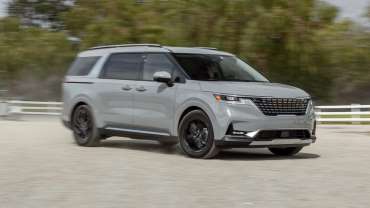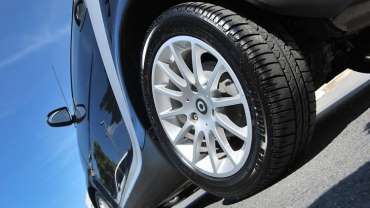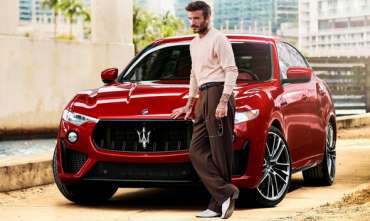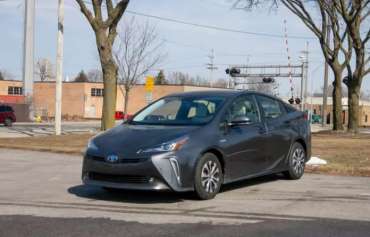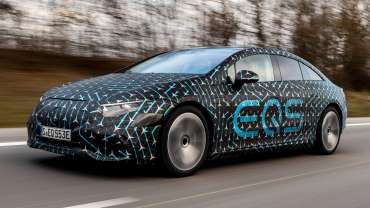
Worldcarblog.com
2022 Kia Carnival First Drive Review: So Long, Sedona
No Ferris wheels or fried dough, but the Carnival is good fun.
Drop the fantasy for a moment. As much as we'd all love to project the rough-and-tumble, outdoorsy ruggedness associated with the deep-voiced sales pitches in SUV ads, how often are you really tackling anything more challenging than a gravel parking lot or a dusty fire road?
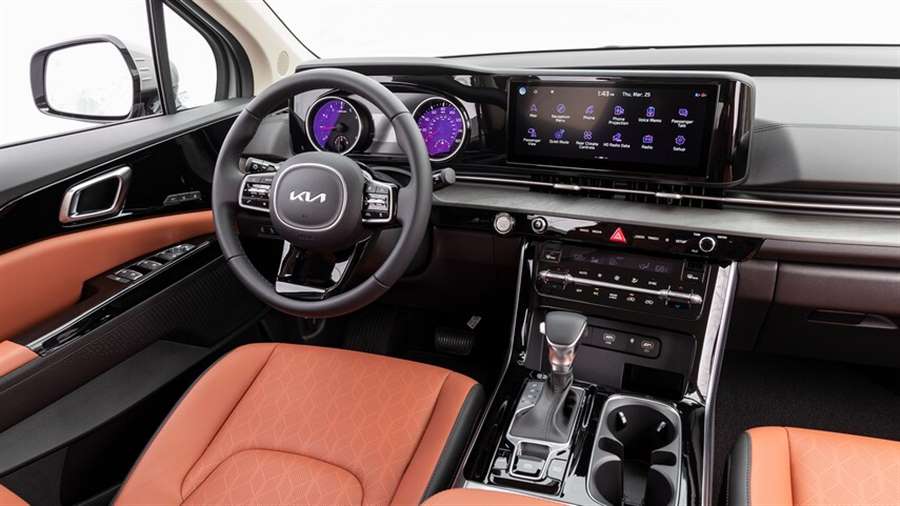
Buyers in need of three-row seating but who won't capitalize on the off-road Sporting aspect of a sport utility vehicle can get loads more utility out of a less ostentatious, less understood class of vehicle. The clever buyer shops for a minivan—or as Kia is calling it, a multipurpose vehicle (MPV). As much as we love the SUV of the year-winning Kia Telluride, the new 2022 Kia Carnival MPV could be a smarter fit for most families.
If you haven't heard of the Carnival, you're not alone. Kia introduced it as a new nameplate for 2022 to replace its Sedona minivan, which Kia has sold in the U.S. since the 2002 model year.
The Carnival rides on a lighter, stronger platform than the outgoing Sedona and features boxy, SUV-inspired sheetmetal reminiscent of newer Kia designs, including the Telluride, Seltos, and Sorento. (A neighbor even asked if it was an SUV or a minivan, which surely would thrill Kia's designers.) This is also the first model to don the newly redesigned Kia badge.
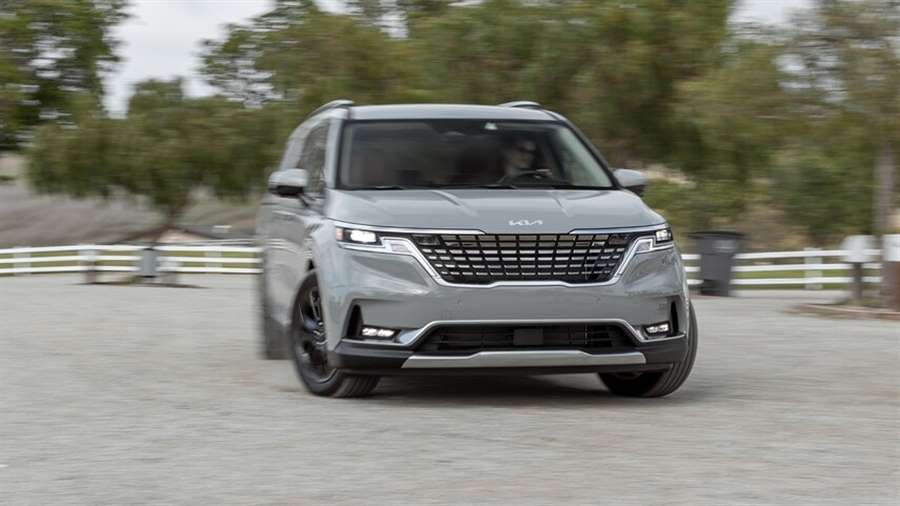
Cavernous Cargo Carrying
The Carnival is more spacious than the van it replaces, too. With 40.2 cubic feet of cargo space behind the third-row bench, it has 6.3 cubic feet more cargo volume than the old Sedona and at least 6.7 cubes more than any other current minivan. Stowing the third-row seats is easily doable with one hand via a chunky handle on the back of the seat, and with the seats folded, the load floor is completely flat.
Space behind the second row is class-competitive but a few cubes behind a comparable Honda Odyssey or Chrysler Pacifica. The Carnival's second-row seats are removable (in all models save the range-topping SX Prestige), a feature the Sedona didn't offer. To do so, lift a lever under the back side of the seat and fold the seat forward; removal requires no more than average adult strength, but the awkward shape means it may be wise to enlist the help of a partner.
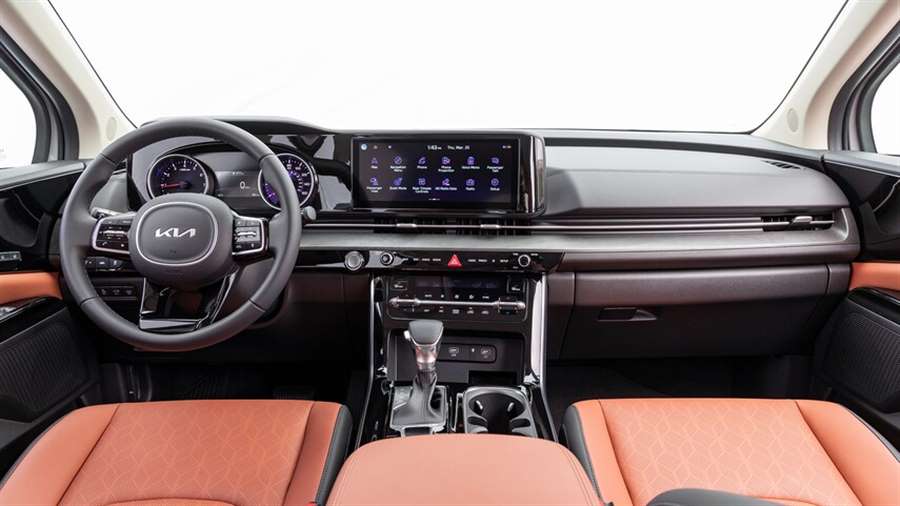
Those planning to frequently swap between using the maximum space behind the first row and using the second-row seats may be better off with Chrysler Pacifica's Stow 'n Go solution rather than wrangling the second-row seats into and out of the Carnival. Once they're removed, however, not only does the Kia have more space behind the first row than any other minivan, but its cargo volume also measures larger than that of the colossal Chevrolet Suburban (145.1 versus 144.7 cubic feet).
Three Roomy Rows Of Seating
But don't go thinking the Carnival is just a cargo van stand-in. The new MPV can be ordered in seven- and eight-passenger configurations, both with ample legroom in all three rows. Third-row access is near effortless with a one-hand pull of a handle beneath the second-row armrest that folds and slides the seat forward; older kids will have no problem operating it themselves. Third-row legroom matches the Pacifica and is a couple inches behind the Sienna and the Odyssey. A 6-foot-1 passenger has just enough legroom in the way back, but their head likely will be brushing the ceiling. Also, the rearmost windows border on claustrophobia-inducingly small.
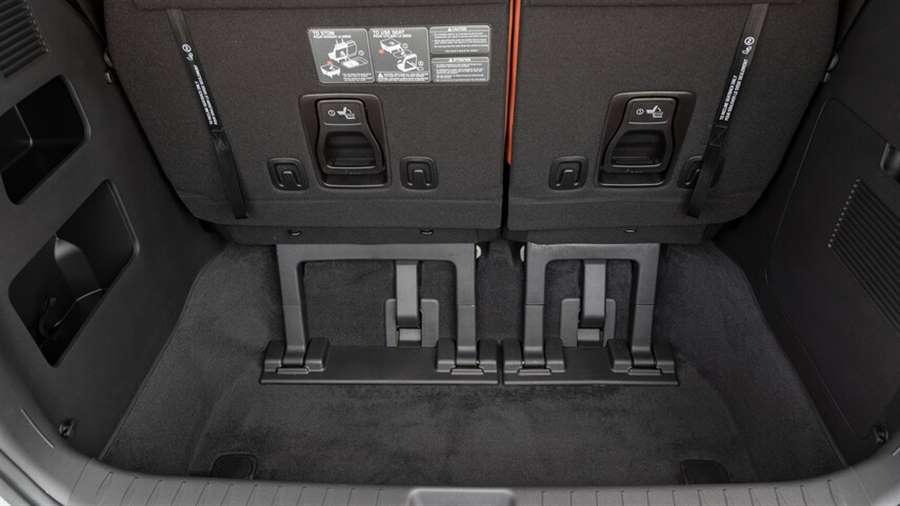
The second row is really where it's at. Beyond the 40.5 inches of legroom, its neat aspect comes with the SX Prestige and its "VIP" second-row seat. The Prestige swaps out the standard second-row bench for two leather-lined, heated, and cooled lounges that are more comfortable than the furniture in most living rooms. You can slide them way back, to make room for the Prestige's party trick: full recline with power-extendable legrests. Friends compared them to the plush recliners in upscale movie theaters. At $47,275, the Carnival SX Prestige is pricey, but it's less than other top-spec minivans. And it easily represents the most luxurious rear seating experience in any car under $50,000.
Up front, there's an 8.0-inch touchscreen infotainment system featuring Apple CarPlay and Android Auto as standard, but that's only on the base model. All other trims showcase a huge 12.3-inch display that's set high on the dash to keep your eyes near the road. Through the infotainment screen, the driver or front passenger can access the cabin camera and the intercom (standard on EX and above), which allow parents up front to talk to and keep an eye on kids in the back without turning around.
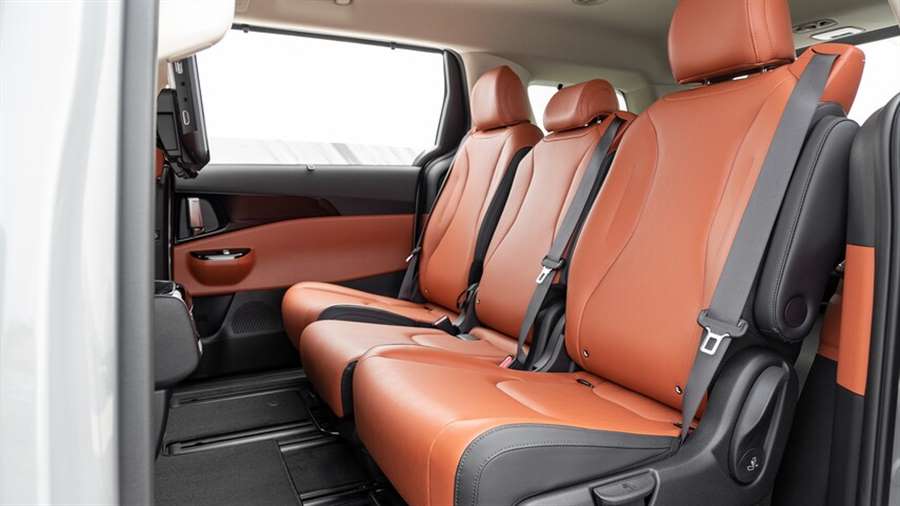
Living With The Kia Carnival
For the most part, it all comes together as a well-executed people mover.
There are six USB charging ports in the car (eight with the rear seat entertainment displays) plus two three-prong household outlets and two 12-volt power outlets. Including the wireless charging pad that's standard on EX trims and higher, it's possible to charge as many as 13 devices at once. The Carnival has 11 cupholders, too—no matter how many people you pack into this thing, no phone need go uncharged and no cup or juicebox unheld.
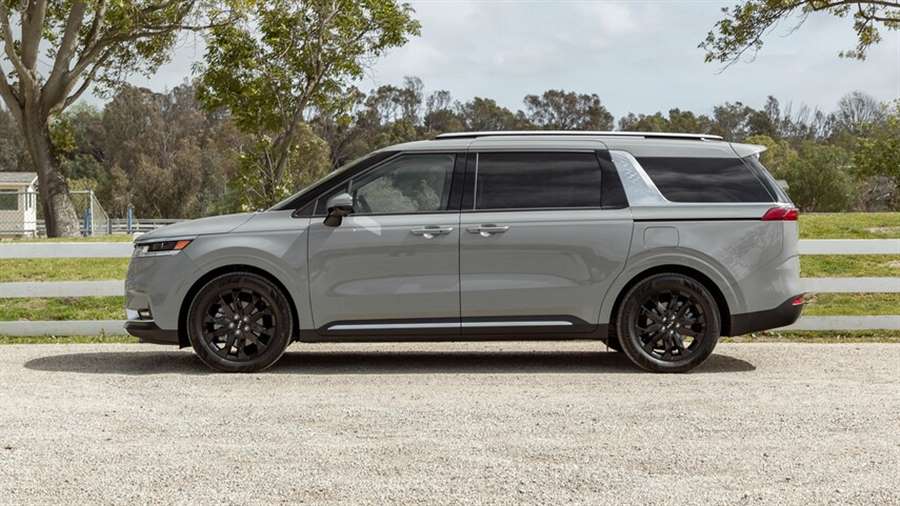
The interior design is just as handsome as the bodywork. Kia integrates metal-look trim throughout the cabin, and leatherette upholstery is standard on the EX and SX. Especially with the Prestige trim's dual 12.3-inch front displays, the cabin gives off real Mercedes-Benz vibes. That said, the metallic trim can cause dangerous glare for the driver in the wrong light. What's more, Kia's overreliance on capacitive-touch buttons for HVAC and infotainment controls can be frustrating, as they lack tactile feedback and can be tough to find without taking your eyes off the road.
SX trims and above include dual 10.1-inch displays as part of a rear entertainment system. The displays feature preinstalled apps for streaming Netflix, Youtube, and Twitch, and there's a kids mode with graphics by Pinkfong, the South Korean children's educational empire behind last year's Baby Shark phenomenon. Factor in the HDMI, USB, and wireless device-mirroring capabilities, and the entertainment prospects are vast.
The rear entertainment displays are not perfect, however. Streaming content through any of the preinstalled apps requires connecting the system to a paired smartphone's Wi-Fi hot spot because unlike its competitors, the Carnival does not include one. In an effort to treat the Carnival as a mobile office for an afternoon, we were also frustrated to find the HDMI input produced a fuzzy, low-res image and too much lag to accurately use a cursor, though Kia insists the examples we drove were pre-production units and this could change.
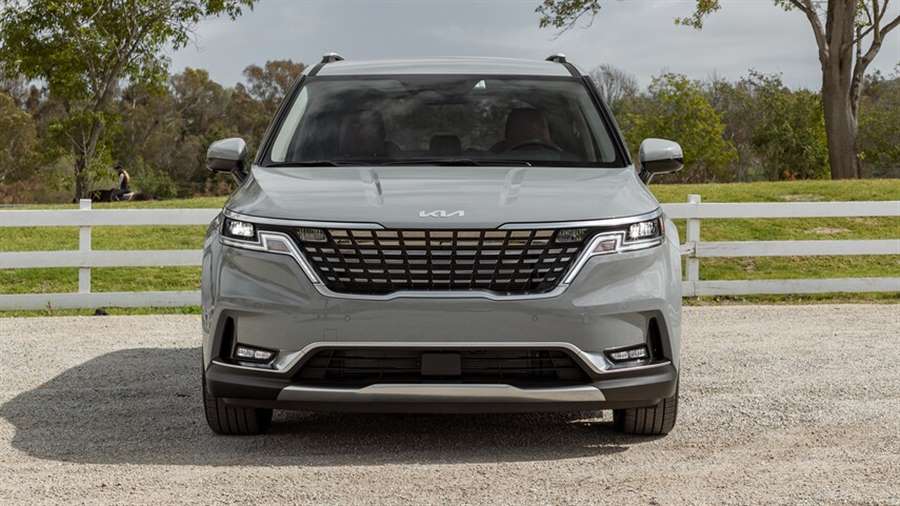
Kia Carnival Driving Impressions
The biggest surprise from our time with the Carnival? How well it drives.
Kia has developed a new 3.5-liter naturally aspirated V-6 for the Carnival. With 290 hp and 262 lb-ft, it's the most powerful engine in the segment and is tied for the most torque. Paired with a smooth-shifting eight-speed automatic that is rarely caught in the wrong gear, the engine provides ample acceleration. The Carnival is also rated to tow 3,500 pounds, which is typical for this class.
Vans like this need to ride well, too, and this Kia achieves that. The combination of relatively soft springs and tires with plenty of sidewall delivers a plushness that won't wake the baby in the back seat if you hit a pothole. More impressive, though, the Carnival exhibits next to no body roll and minimal secondary ride motions. It's genuinely fun to drive. And when you're just on a highway slog, Kia's lane centering and adaptive cruise control systems are among the best in the business.
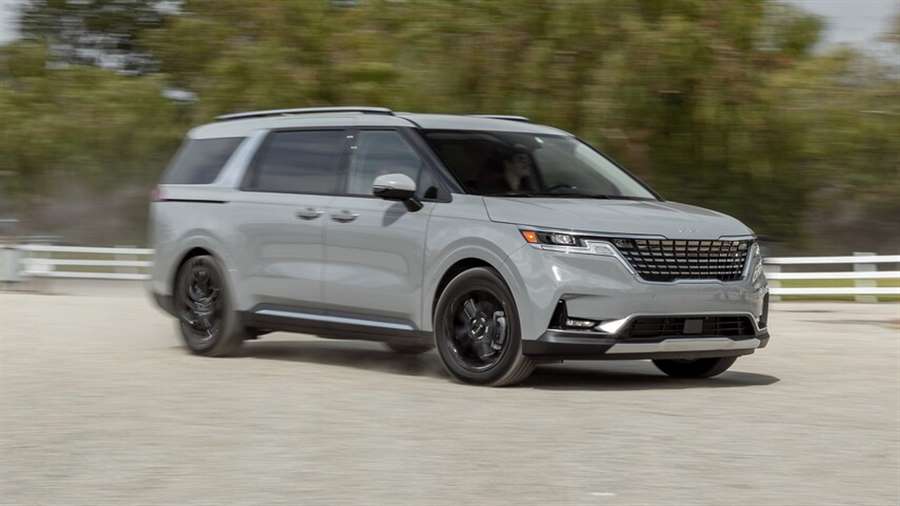
That Highway Driving Assist is part of a generous collection of driver assist active safety tech. Automatic emergency braking, pedestrian detection, lane centering, blind-spot monitoring, rear cross-traffic alert, driver attention warning, and rear occupant alert are all standard, even on the base model. The EX trim adds front parking sensors and Highway Driving Assist adaptive cruise control; the SX gains auto rear braking and an (invaluable) high-res 360-degree camera system; and the SX Prestige boasts a blind-spot camera feed in its 12.3-inch digital instrument cluster.
Our only complaint about the mechanicals is the lack of choice. With the new Sienna debuting with a hybrid-only powertrain and Chrysler offering a plug-in hybrid Pacifica, some buyers will be dismayed by the Carnival's 22 mpg combined fuel economy rating. (Queried about the lack of a hybrid offering for the Carnival, a Kia representative said, "Be on the lookout for what's in store. ") Drivers in colder climates may also be lured away by Chrysler and Toyota's available AWD—the Carnival is FWD only.
The Verdict
We mentioned earlier that Kia is marketing the Carnival as an MPV, a multipurpose vehicle. Nothing wrong with that; it can manage stand-in duty as a comfortable road tripper, an executive luxury limo, or even a full-blown cargo hauler.
But consider the Carnival's strengths: smooth ride; thoughtful, family-friendly features; intuitive tech; and a vast, high-quality cabin. Lean in to the stereotype, Kia. The Carnival is an excellent modern minivan.
New EU tire labels from 1 May
The EU tire label, introduced in November 2012 as a binding label, shows rolling resistance (fuel consumption factor), rain grip and noise, and the new one from May 2021 is clearer, more interactive and clearer…
Autoportal writes that tires, that is, tires, are the most important part of a car, because only with tires, with an area of four human palms, does a car touch the ground (road). This allows you to drive on the desired path and ensures handling, stability and braking of the car.
Driving tires create rolling resistance, which directly affects the car's driving characteristics and fuel consumption and noise, and at the same time wears out. It is a kind of necessary evil, because it creates negative work (mechanical losses), which worsens the car's performance and increases fuel consumption. The rolling resistance of the tire cannot be abolished, but it can be reduced.
Rolling resistance makes up 10 to 30 percent of driving resistance, depending on the speed and slope of the road, engages as much effective energy of the car engine and directly affects fuel consumption.
The smoother and harder the tire, the lower the rolling resistance, but also the worse the grip. Especially on wet and slippery roads. Traction in the rain, which creates slip resistance and shortens stopping distances, is extremely important for steering and driving safety.
The third feature of a car tire is noise when driving, because when the tire rolls, vibrations and sound waves, from the contact surface, are transmitted to the cabin and affect driving comfort. Tire noise has a detrimental effect on the environment, especially around highways. But it does not affect driving characteristics and safety.
In November 2012, EU legislation prescribed that every tire must have markings that show what characteristics car tires have according to these characteristics (rolling resistance, wet grip and noise).
Rolling resistance has so far been classified into seven categories (A, B, C, D, E, F, G) with the proviso that it has been divided into two areas, each with three gradations - good (A, B, C) and bad (E, F, G). D was an empty area, a kind of buffer zone. Noise was vividly described by sound waves - one, two and three, with quantification of the maximum noise intensity, by the number of decibels (dB).
The new EU mark, a binding label on every car tire, or classification, which comes into force on May 1, 2021, is more logical and clear. The grades of rolling resistance and grip on wet roads are divided into five categories, with A being the best. Categories A, C and E are marked with colors as on the traffic light - green, yellow, red, and B and D are intermediate colors - light green and orange.
According to the new, the noise level is marked with A, B and C, from the smallest to the largest. The new EU label also introduces a separate classification for snow tires (symbol of Triglav with a snowflake) and ice (spike with ice). Additional information on the tire label is the type designation, with the item number, adapted to the standard sales network.
The Spanish government subsidizes the purchase of electric vehicles
The Deputy Prime Minister of Spain and the Minister of Ecology, Teresa Ribera, stated that the Government will support the purchase of electric vehicles with 400 million euros.
This program, which can be increased to 800 million euros, will last until 2023, and it is also intended for individuals and companies. Part of the funds will also be used to install filling facilities, writes "La Vanguadria".
She says that for the purchase of passenger cars, you can get up to 7,000 euros for a car and 1,300 euros for the purchase of an electric motorcycle.
The novelty is that the program also subsidizes up to 9,000 euros for the purchase of an electric van.
Registration has started, and the goal is to have 250,000 electric vehicles and 100,000 charging places on Spanish roads by 2023.
"This will avoid 450,000 tons of carbon dioxide and create employment at a critical time for the economy," the minister said.
David Beckham is the new brand ambassador of Maserati
Thanks to the recent debut of the MC20 supercar, Maserati is once again attracting attention, and the new brand ambassador will definitely help in that.
In addition to the MC20 supercar, Maserati is also preparing to present its new crossover called Grecale, which will be sold with the Levante model. The company has to sell more cars in order to survive, and the new brand ambassador will try to help it in that.
He is a former football star, a player of Manchester United, Real Madrid, Milan, Los Angeles Galaxy and PSG, the phenomenal Englishman David Beckham (David Beckham). Beckham is known as a car lover and has owned several fantastic cars including the Aston Martin V8 Volante, McLaren 720S, Porsche 911 Turbo Cabriolet and others.
Maserati says Beckham will "bring the brand forward to the forefront of luxury cars in the 21st century" as the company prepares to enter a new electric era.
"The brand is moving forward. Maserati is innovative by nature, driven by passion and has a unique design. The partnership with David is the embodiment of those values," said Pase Tubito, head of marketing at Maserati.
"This is an exciting time for me to start a partnership with Maserati, a legendary Italian brand that shares my passion and respect for innovation and design. I look forward to working together at this important time in their history and continuing their work globally," he said. Beckham.
Maserati has not revealed details about the partnership, but Beckham will definitely appear in promotional clips and when launching new models. The first video, already released, marks the beginning of a partnership, and shows the popular Becks neglecting his busy schedule for a moment to have fun at the Maserati Levante Trofeo in Miami. The powerful 3.8-liter twin-turbo V8 engine that develops 590 hp and 730 Nm of torque allowed it to "ignite the tires", which cheered him up and caused a smile on his face.
Beckham really did everything himself during the filming of the promotional video under the supervision of professional drivers.
Toyota Prius Review: High Mileage, for a Price
The verdict: Sky-high fuel efficiency with front- or all-wheel drive remains the main draw for Toyota’s iconic Prius hybrid, even as the aging current generation grows less competitive in other ways.
Versus the competition: When Toyota unveiled this generation of the Prius more than five years ago, we lauded the car’s advancements in handling and interior quality. The intervening years, however, have seen rivals catch up on fuel efficiency and pull ahead in refinement and other technologies — though none yet offer all-wheel drive.
Toyota added the option of AWD to the Prius two model years ago, and it remains one of the most fuel-efficient cars of its type, at least before you look at plug-in vehicles. The AWD Prius comes in LE and XLE trim levels; we evaluated an XLE. The Prius can be had with front-wheel drive in five trims, including a limited-run 2020 Edition that commemorates two decades since the Prius debuted. (Heritage notwithstanding, it’s a baffling move; slapping “2020 Edition” on a 2021 model invites needless confusion, not to mention a constant reminder of a year everyone wants to forget.)
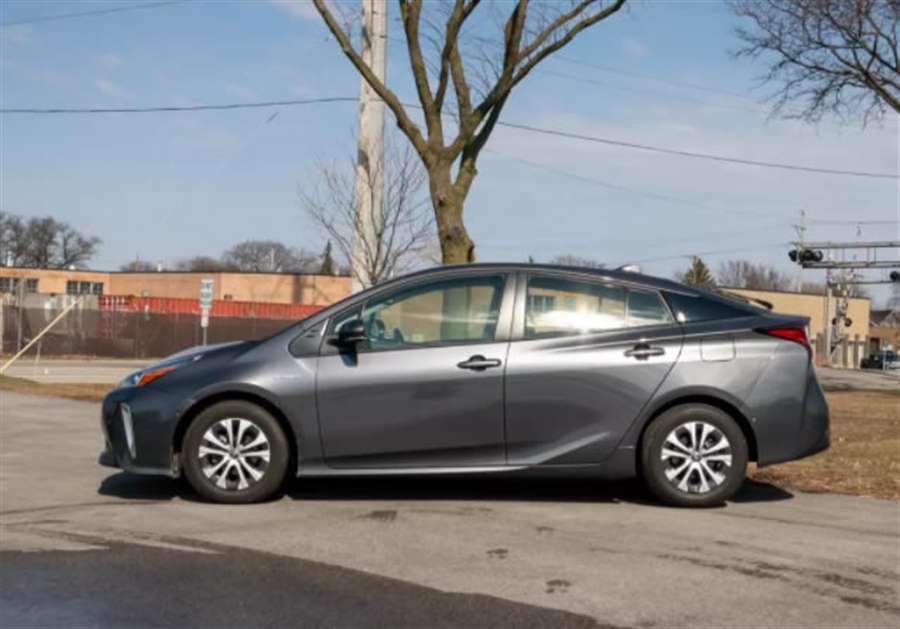
Besides the 2020 Edition, changes for 2021 include some augmented safety features and new Android Auto smartphone connectivity on most trim levels (Apple CarPlay remains standard). Stack up the 2020 and 2021 Prius or compare 2021 trim levels. Note, we separately cover the Prius Prime, a plug-in hybrid with an EPA-rated 25 miles of all-electric driving range on a full battery charge before the gas engine kicks in. (Here’s more about the main differences between a hybrid and plug-in hybrid.)
Gas Mileage: The Reason Anyone Buys a Prius
The Prius’ mileage leader is the L Eco, a base trim level that’s good for an EPA-estimated 56 mpg combined. Among plug-free cars, that rating trails only one rival: the Hyundai Ioniq Hybrid, whose base trim level, Ioniq Blue, gets an EPA-rated 59 mpg combined. That said, the L Eco trim accounts for less than 10% of Prius cars listed in Cars.com’s dealer inventory as of this writing. Most shoppers will end up with other trims of the Prius, which the EPA still rates a very good 52 mpg combined.
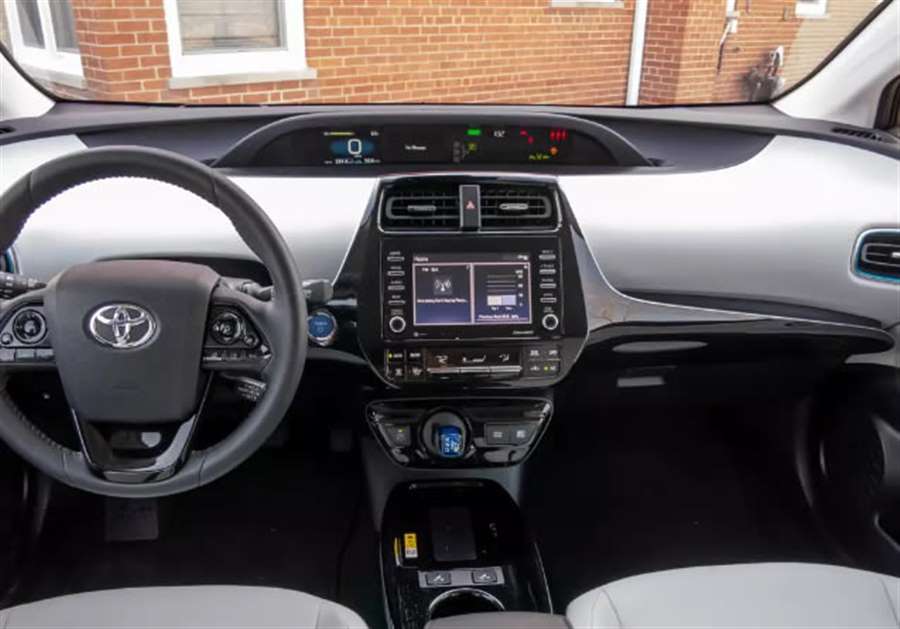
The Prius AWD, meanwhile, employs an additional electric motor at the rear axle, which powers the car continuously from a stop, then as-needed up to 43 mph. There’s no mechanical connection to the main powertrain, which pairs two electric motor-generators with a 1.8-liter four-cylinder engine. A power-split device with continuously variable properties doles out power to the wheels.
The whole of it makes for a combined 49 mpg in EPA ratings — short of the front-drive Prius but outstanding for an AWD vehicle that isn’t a plug-in. Our real-world testing returned results consistent with the car’s rating, with 46.6 mpg according to our calculations based on fill-up mileage ( 51.5 mpg on the trip computer) after 215 miles of mixed highway and suburban driving.
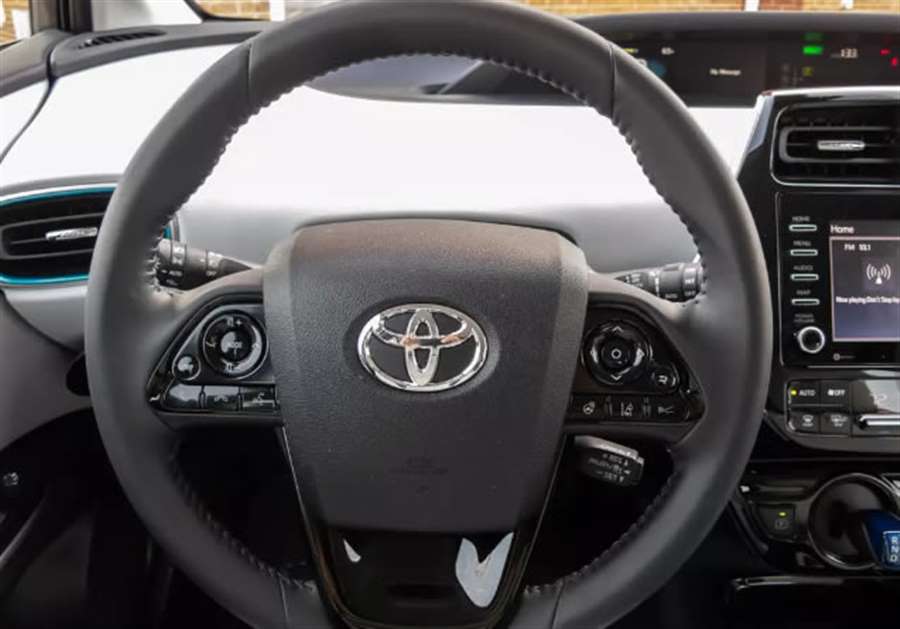
What You Give Up to Get There
As with most hybrids, electric operation alone is possible at low speeds under light acceleration, with the engine kicking in for anything beyond that. Under a combination of engine and electric power, the Prius has enough oomph; I needed most of the drivetrain’s reserves to claw my way up to 40 mph with 17 bags of mulch aboard — at least several hundred pounds — but power felt workably adequate.
That’s not to say the drivetrain is all that responsive. Press the accelerator while already in motion, and the Prius hesitates a beat or two before raising rpm to pull noisily ahead. Most modern CVTs implement quicker rpm transitions to mimic a step-gear downshift, but such programming usually trades fuel efficiency for responsiveness, so I seldom observe it with the CVT-style transmissions many hybrids use. The Prius, unsurprisingly, does none of that: Engine revs meander up or down in a slow, old-school fashion.
A few other downsides persist. Toyota’s regenerative brakes — a feature employed in all hybrids — impart a nonlinear pedal feel reminiscent of the technology’s early days. Response is tentative in the first inch or so of pedal travel, then becomes suddenly sharper as you press harder. So-called pedal linearity has improved among many hybrids over the years, even as a few non-hybrids introduce new forms of it.
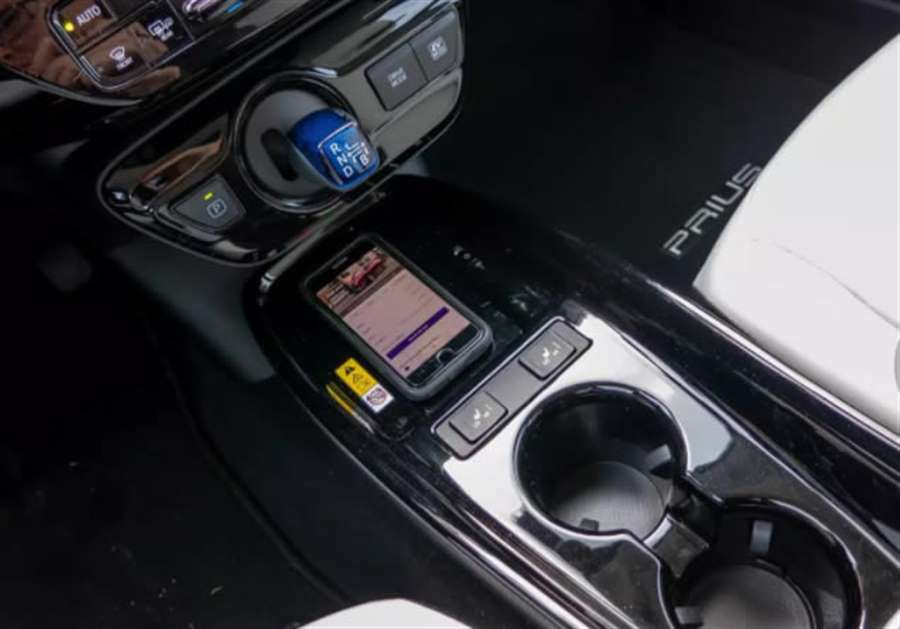
Ride quality and noise abatement also remain areas that could use improvement. At highway speeds, our test car’s efficiency-oriented Bridgestone Ecopia tires let out quite the howl, with adjacent trucks matching the ambient noise. The suspension sorts out minor bumps well enough, but anything significant sends turbulent aftershocks through the body. The Prius is not especially comfortable or quiet.
Is this the penalty for sky-high mileage at an affordable price? Maybe; the rival Honda Insight is no bank vault, either. Mass-market hybrids aren’t known for sophisticated suspensions or gobs of noise insulation, but some execute those things better than others. A redesigned Prius will probably improve on such aspects, and with the current Prius entering its sixth model year for 2021, time for a new version is nigh.
By contrast, the Prius’ hybridness has little bearing on its other deficiencies. Most trims get a touchscreen measuring just 7 inches diagonally — an inch short of what you’ll find in the base version of many mass-market cars — with modest screen resolution and undersized volume and tuning knobs. Apple CarPlay, Android Auto and Amazon Alexa integration are included with the 7-inch system, but they require a tethered connection as opposed to the wireless integrations that are expanding industrywide. Upgrade to the front-drive Prius Limited and you get the Prius Prime’s 11.6-inch vertically oriented touchscreen, but it confoundingly loses Android Auto connectivity. See our impressions of it otherwise.
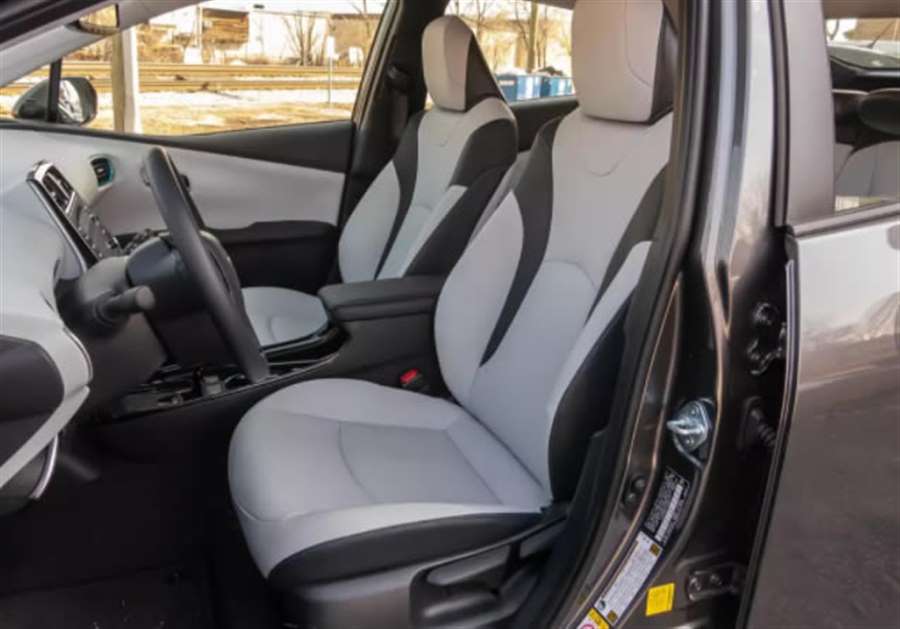
Where It Still Shines
An early example of Toyota’s well-executed TNGA platform, which now underpins many other cars, the Prius boasts improbably good handling. The steering has a touch of vagueness on-center, but it communicates lively feedback as you turn the wheel into corners. Body roll is nicely controlled, and the AWD model shows unexpected balance if you slide it around — something the Bridgestones easily allow.
Space efficiency, at least up front, is also among the Prius’ strengths. The low center console leaves good space for your knees and thighs, and all but the tallest drivers should find sufficient headroom, even with the seat elevated all the way. The backseat is a bit low to the floor, so adults may find their knees uncomfortably elevated, but we found sufficient clearance to fit bulky rear-facing child-safety seats behind a 5-foot-6-inch front passenger. (That’s not to say, however, that the Prius passed Cars.com’s Car Seat Check with flying colors; parents with young children should check out our full scoring.)
We measured 13.1 cubic feet behind the Prius’ backseat, a figure comparable to our audits for two other smallish hatchbacks, the Mazda3 (13.1 cubic feet) and Subaru Crosstrek (13.0 cubic feet). (Note that our independent accounting of cargo space differs from manufacturer specs, which we’ve found overrepresent hatch space, underreport trunk volume and are unreliable for comparison.)
The Prius earned top scores in most crash tests by the Insurance Institute for Highway Safety, but suboptimal results in the passenger-side small overlap front test kept the vehicle from garnering one of IIHS’ influential, if widespread, Top Safety Pick awards. Still, Toyota’s long list of safety and driver assist features is impressive: Automatic emergency braking with pedestrian detection, lane departure steering assist and automatic high-beam headlights are standard, as are adaptive cruise control and hands-on lane centering. Those last two features can both operate from a standstill all the way up to highway speeds. New for 2021 is the latest generation of Toyota Safety Sense, which adds more detection capabilities, and all but the base trim level get a blind spot warning system with rear cross-traffic alert. Top trims add curve-adaptive headlights.
Should You Buy a Prius?
The Prius starts around $25,500 for the cheapest front-drive trim. That’s roughly commensurate with Toyota’s immediate competition, and the base Prius doesn’t skimp on multimedia features or safety and driver-assist tech, as some rivals do. Optional AWD adds a modest $1,000-$1,400 to the Prius’ mid-level trims, depending on specifics; the cheapest AWD Prius lands comfortably under $30,000 (all prices include destination charges).
Ascending trim levels add items like faux-leather upholstery, heated front seats and a power driver’s seat. Oddly enough, you can’t get certain top-of-the-line features on any AWD model, and niceties like a memory driver’s seat, dual-zone climate control and genuine leather are unavailable on any 2021 Prius.
Loaded with factory options, the Prius tops out around $34,500. You should be able to find plenty of examples well below that, given about two-thirds of the new 2021 models listed on Cars.com are priced at or below $30,000. Still, budget-conscious shoppers might find wider affordability on the Insight, with 82% of its new 2021 models priced at or below $30,000 on Cars.com.
That said, the venerable Prius is bound to find plenty of shoppers. The current generation shows its age through its drivability and multimedia tech, but lower trim levels offer a good mix of value and efficiency — especially with AWD, a capability that hybrid shoppers would otherwise need an SUV to get.
Consequences of Brexit: The British in France are threatened with astronomical fines because they do not have a driver's license
The French government previously announced that the British living in that country will have to replace their British driver's license with a French one because of Brexit, but many of them did not do that, writes The Guardian. Some of them are now afraid that they will lose their jobs, others are afraid that they will have to return to Great Britain.
In the worst case, Britons living in France will have to take driving tests in France. In order to do that, they are obliged to attend classes and pass the theoretical exam in French. Obtaining a French driver's license costs around 1,800 euros, writes the HAK magazine.
When the Brexit option without an agreement appeared in 2018, about 100,000 Britons applied to exchange their British driver's license for a French one, but some of them did not. The French government announced late last year that the British in France would have to submit a request by December 31, 2021.
However, since January, the new French online licensing system has systematically rejected all requests, because there is (yet) no agreement between Great Britain and France in this area. It is currently estimated that there are around 3,000 Britons who are seriously concerned. Some of them do not have a valid driver's license because the old one has recently expired. If you are caught driving in France without a valid driver's license, the fine is up to 15,000 euros.
New Mercedes EQS prototype review
From behind the wheel, the late prototype version of the Mercedes EQS reveals the tech-packed EV’s quiet and refined character
Verdict
The Mercedes EQS is the kind of car where you don’t miss a combustion engine. It’s all about refinement, which it seriously delivers. It’s surprisingly agile given its size and weight, while performance is strong.
This is our first chance to sample the new Mercedes EQS – the company’s all-electric flagship – ahead of its world premiere, and from our experience of this late-stage prototype, the technology is certainly something impressive.
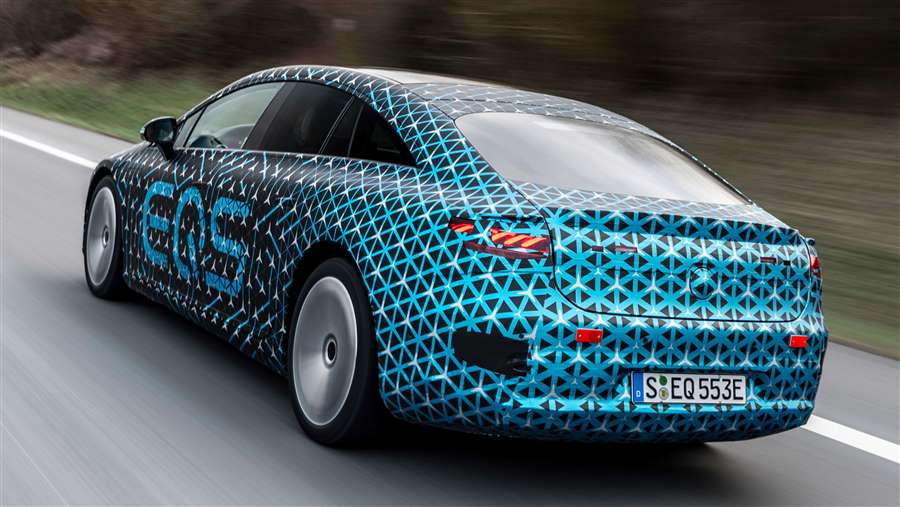
Mercedes recently revealed more EQS specifications, with an EQS 450+ and an EQS 580 4MATIC available from launch. It’s the latter we’re testing here, and with 516bhp and 855Nm of torque, even for a 2.5-tonne car the EQS pulls powerfully and smoothly. The thrust on offer is considerable, but it’s superbly relaxing.
Electric cars with the longest range
That’s thanks to the incredible refinement the car offers. The pair of electric motors give four-wheel drive and very little whine, so cruising along in the EQS is hushed, helped by an ultra-low drag coefficient of just 0.2Cd, so the experience fits perfectly with the luxury demands of this electric limousine.
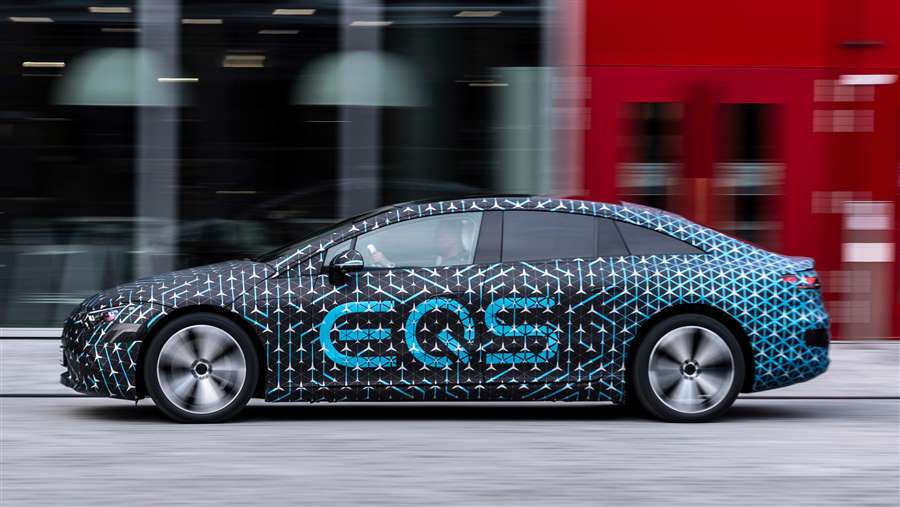
Adaptive air suspension is standard, and again, despite the weight due to the big battery (two battery sizes will be offered from launch, a 90kWh unit and a 108kWh pack, which offers up to 478 miles of range), the EQS drives with a light touch.It smooths bad surfaces and filters out the worst the road can throw at it.
However, you’re not completely decoupled from the driving experience, even if the car packs plenty of driver-assistance systems. Instead, the air suspension removes the bad elements, yet still offers a degree of connection between driver and machine, which is certainly refreshing.
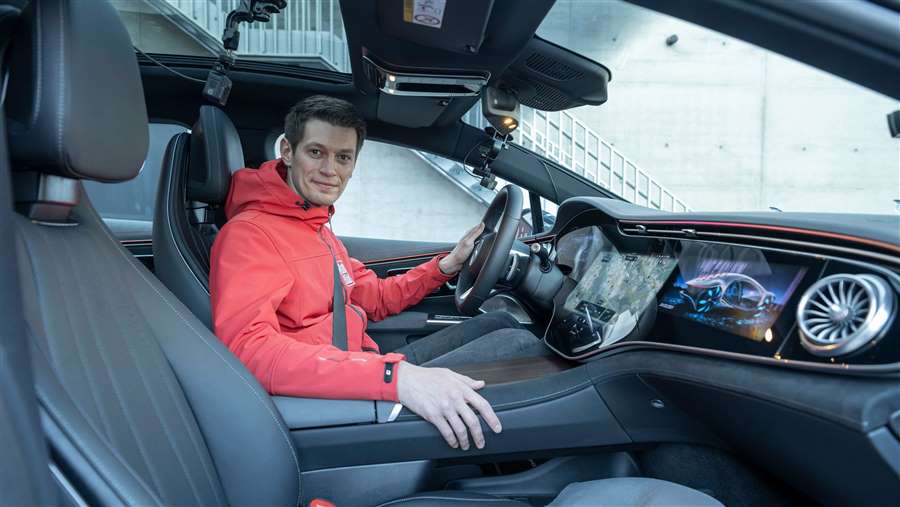
The steering is light, but for a 5.2-metre-long car the EQS is surprisingly nimble, too. Rear-axle steering is fitted to help boost agility and give a feeling that the EQS is smaller and lighter than it actually is. It definitely helps manoeuvrability in built-up areas, and out of town the Mercedes corners well for a range-topping saloon, with great traction and strong punch out of bends thanks to that huge torque being supplied to all four wheels. The brake regeneration is great too and allows for easy one-pedal driving in its strongest setting, while there’s also an adaptive auto mode.
There are some sound and ambient light programmes designed to inject a bit more emotion into the driving experience, but we’d say you don’t need them.
There are some drawbacks. Given the location of the battery in the car’s floor, you sit quite high, so headroom might be a little limited if you’re tall. From the driver’s seat you also can’t see the bonnet – although you soon get used to placing the car on the road. It’s partly due to the high dashboard that features the EQS’s party piece: the 55.5-inch curved Hyperscreen infotainment system, which is beautifully crisp and clear.
autoexpress.co.uk

